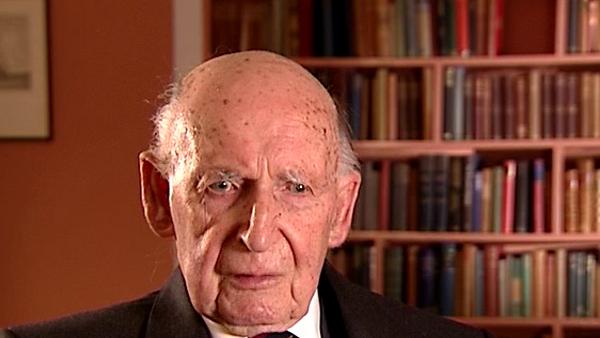NEXT STORY

Complaining about the lack of facilities on the radar project
RELATED STORIES

NEXT STORY

Complaining about the lack of facilities on the radar project
RELATED STORIES



I didn't really know anything about the ionosphere. I knew it existed and what it was, but it occurred to me that... still my mind on what I'd left in Manchester that what were the echoes? Could they be this powerful radio echoes from the high energy showers which I had been studying, for the ionisation of these great showers in the high atmosphere. Then I forgot about it and so the war began. I was appointed a junior scientific officer. As a matter of interest, the salary was then £300 a year, which seemed quite a lot of money, and I was posted to an airfield near Perth in Scotland, Scone of famous history. The main establishment from Bawdsey had been evacuated to Dundee, and it had been a gorgeous error and mistake which is now in the history books. I was sent to work with Taffy Bowen, EG Bowen and he had formed a group to deal with airborne radar.
Now, Tizard had foreseen that the chain home stations, which then surrounded the coast would enable fighter command to defeat any raids which the Germans make in daytime, and with great foresight he then thought that the Germans would turn to night bombing, and so he had encouraged the formation of this new group under Taffy Bowen to find out how to convert these enormous great chain home radar stations into simpler, which one could put into one's night fighters, so I joined that group. It was chaotic. In this airfield, it was a private airfield. There were hangers containing small Gypsy Moths. It was grass. There was no runway. There were no facilities whatsoever, and I... there was a small group. Bowen had devised a very elementary airborne air interception equipment which he had fitted in a two engine Blenheim. The equipment consisted of two thermionic valves, working on what was a very short wave length of 1.5 metres. The transmitter was a dipole on the nose of the aircraft and he had developed the system already such that the receiving aerials were on the wings of the aircraft, again dipoles, and there was a device which compared the echoes from supposed enemy aircraft, so that if you equalise them on the cathode ray tube, then you were heading for the enemy aircraft. I had my first flight in this Blenheim aircraft, from Scone airfield a really bumpy ride, sitting on a parachute and I must say I was... in that autumn, I was far more interested in the beauty of the snow covered Scottish mountains than I was in what was happening on the cathode ray tube.
Bernard Lovell (1913-2012), British radio astronomer and founder of the Jodrell Bank Observatory, received an OBE in 1946 for his work on radar, and was knighted in 1961 for his contribution to the development of radio astronomy. He obtained a PhD in 1936 at the University of Bristol. His steerable radio telescope, which tracked Sputnik across the sky, is now named the Lovell telescope.
Title: Work with Edward George Bowen on airborne radar
Listeners: Megan Argo Alastair Gunn
Megan Argo is an astronomer at the University of Manchester's Jodrell Bank Observatory researching supernovae and star formation in nearby starburst galaxies. As well as research, she is involved with events in the Observatory's Visitor Centre explaining both astronomy and the history of the Observatory to the public.
Alastair Gunn is an astrophysicist at Jodrell Bank Observatory, University of Manchester. He is responsible for the coordination and execution of international radio astronomical observations at the institute and his professional research concerns the extended atmospheres of highly active binary stars. Alastair has a deep interest and knowledge of the history of radio astronomy in general and of Jodrell Bank in particular. He has written extensively about Jodrell Bank's history.
Tags: Manchester, World War II, Perth, Scotland, Bawdsey, Dundee, Blenheim, Scone, Edward Bowen, Henry Tizard
Duration: 4 minutes, 24 seconds
Date story recorded: January 2007
Date story went live: 05 September 2008